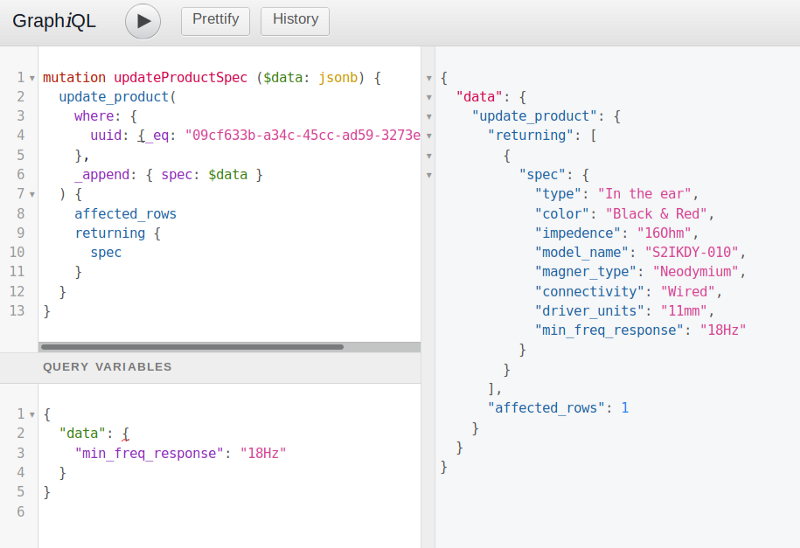

POSTGRES JSON QUERY CODE
I don't often get to write code so it's easy for me to jump back in. The clear to read/easy to intuit form of language I appreciate, perhaps because I work around a lot of Ruby developers, but personally align more with Python. Using JSON interchangeably, but please in your app mostly use JSONB unlessĮxplicitly meaning the more simplistic JSON text format. While you can index JSON you have to index each path. JSONB also comes with some better indexing ability in JSONB unlike JSON compresses the data down and does not preserve whitespace. Just quickly insert a ton of it (a great example use case for this is recordingĪPI/log input where you may want to play requests). This is quite useful if you don't want to index most of the JSON and want to Thisĭatatype will ensure you insert valid JSON into it, but will store it as text.

JSON still exists within Postgres and if you do:ĬREATE TABLE foo (id serial, mycolumn JSON) You'll get a JSON datatype. Minute, first though it is worth some summary disclaimer on the differenceīetween JSON and JSONB. I'll get into this small but pretty incredible change in Postgres 14 in just a In Postgres 14, the JSONB support is indeed getting way better. My likes to state that the B stands forīetter. Got more proper JSON support with the JSONB datatype. Two years later in 2014 with Postgres 9.4 we I put JSON in quotes because well, 10 years ago when weĪnnounced JSON support we kinda cheated. Let’s create a few tables and use the json type.Nearly 10 years now. The json type also preserves the order of keys, duplicates, and whitespace characters. When we use the data, Postgres has to reparse it on each execution. It stores the exact copy of the text we put in. The first column type we want to look into is json. We would miss on a ton of features that Postgres provides to help us work with JSON. In theory, we can store JSON as a regular string. Fortunately, PostgreSQL has tools to deal with it. Some parts of our schema might be fluid and change frequently, though. Using MongoDB has its pros and cons, and we might still want to use an SQL database instead. With this approach, we can describe any data structures with ease. There are databases like MongoDB that store JSON-like documents. This approach has many benefits, but sometimes, we want some more flexibility, though.Ĭhances are you already know JSON and use it in your web applications. So far, in this series, we’ve used PostgreSQL to store data structured in columns. Interacting with the application through REPL Improving PostgreSQL performance with indexes using MikroORM Implementing soft deletes using MikroORM and filters Transactions with PostgreSQL and MikroORM Relationships with PostgreSQL and MikroORM Introduction to a monorepo with Lerna and Yarn workspaces Using ETag to implement cache and save bandwidth Storing files inside a PostgreSQL database Implementing soft deletes with PostgreSQL and TypeORM Generating documentation with Compodoc and JSDoc Introduction to logging with the built-in logger and TypeORM
POSTGRES JSON QUERY PATCH
Updating with PUT and PATCH with MongoDB and Mongoose

Definining indexes with MongoDB and Mongoose Implementing pagination with MongoDB and Mongoose Managing transactions with MongoDB and Mongoose Virtual properties with MongoDB and Mongoose Verifying phone numbers and sending SMS messages with Twilio Setting up recurring payments via subscriptions with Stripe

Using Stripe to save credit cards for future use Using server-side sessions instead of JSON Web Tokens Managing PostgreSQL relationships with Prisma Real-time updates with GraphQL subscriptions Sending scheduled emails with cron and Nodemailer Implementing in-memory cache to increase the performance Communicating with microservices using the gRPC framework Using RabbitMQ to communicate with microservices Offset and keyset pagination with PostgreSQL and TypeORM Using the array data type with PostgreSQL and TypeORM Defining transactions with PostgreSQL and TypeORM Improving performance of our Postgres database with indexes Testing services and controllers with integration tests Creating relationships with Postgres and TypeORM Looking into dependency injection and modules Serializing the response with interceptors Authenticating users with bcrypt, Passport, JWT, and cookies Setting up a PostgreSQL database with TypeORM Controllers, routing and the module structure This entry is part 22 of 69 in the API with NestJS


 0 kommentar(er)
0 kommentar(er)
